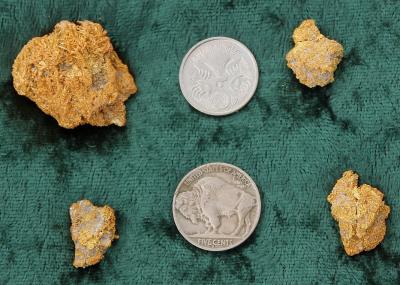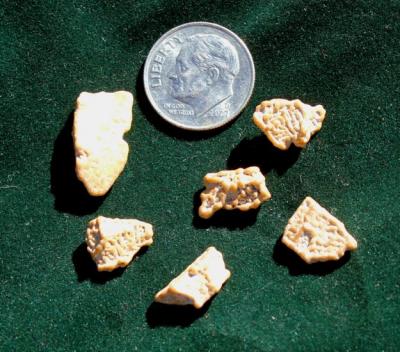-
Posts
883 -
Joined
-
Last visited
Content Type
Forums
Detector Prospector Home
Detector Database
Downloads
Everything posted by Reno Chris
-

What Coil Size Do You Most Want For The GPZ 7000?
Reno Chris replied to Steve Herschbach's topic in Minelab Metal Detectors
The stock coil is a good choice, but in ground cluttered with lots of rocks and bushes, I find it is tough to get into tight places and many times this is where the gold is hiding. Its fine in open, sparsely vegetated country as in northern Nevada or Western Australia, but not everywhere is like that. In past years on my other ML machines I have rarely used a coil this large except as a final patch cleaner to check for deeper stuff. So I would prefer a smaller coil - 11x8 or 11x9 would be fine. Once available, that smaller coil would probably become my primary coil on the GPZ. -

Let's Give The Detector A Little More Credit
Reno Chris replied to hawkeye's topic in Detector Prospector Forum
Yes, the detectors are great, but I disagree with you. Far too many times I have seen new guys with the latest and best equipment go months and even years without finding a single nugget. No detector can locate gold if it isn't there. You the prospector have to put the coil over a nugget for it to be useful. If you don't have that skill, the detector, no matter how great, cant help you. -

Interchanging Metal Detector Coils?
Reno Chris replied to Professor Hester's topic in Metal Detector Advice & Comparisons
What is your intent for your detector? Coins and Jewelry in local parks? Nuggets in the goldfields? Treasure caches? -

Interchanging Metal Detector Coils?
Reno Chris replied to Professor Hester's topic in Metal Detector Advice & Comparisons
For someone who has so little knowledge of the operation of detectors, you ask a whole lot of questions! Coils have many characteristics such as inductance, capacitance, etc. The design of a detector must take into account these "other " characteristics. It is not just about the kHz which a detector is designed for. It makes a big difference if a coil consists of 40 windings or 400. Additionally, metal detector sensor heads or "coils" may consist of many coils - I have seen designs with as many as 5 separate inductor coils. I would start with just a basic understanding of coils, or inductors as they are known to those with experience in electronics. See: http://en.wikipedia.org/wiki/Inductor Carl Moreland's book (linked to in Steve's post above) is an excellent reference and will answer the bulk of your questions. Since they are YOUR questions, do the work and discover the answers for yourself. Any real professor would tell you that self motivated investigation is the best way to learn any subject. When your efforts are complete, come back here and tell us about what you have learned. -
Great work and thanks for posting.
-
Yep, March 7-8 - that's the one.
-
There's a show in Stockton coming up soon. Closest to Nor California you will get this year.
-
Amazing how similar that location looks to so many places in northern California that I have detected, but its someplace in Victoria.
-
All I can say is for me, if you put a detector in my hands, and then tell me it goes deeper than other detectors, I want to use it to find gold. I don't want to make videos, do tests, comparisons, etc. - I want to dig gold! So I went out with the GPZ and I did find gold with it and I was impressed. Rick - Here is my suggestion: Lets get together in the not-too-distant future, and I'll loan you my 7000 for a while and you can do all the tests you would like or you can just go find gold with it - its up to you and you can form your own opinions. Sound reasonable?
-

Steve H. Speaking in Reno
Reno Chris replied to Sourdough Scott's topic in Detector Prospector Forum
It was fun. Lets do it again in 6 months or so. -

Removing Gold From The Country You Find It In?
Reno Chris replied to rumblefish's topic in Detector Prospector Forum
Every country has different laws - there is not one universal rule for all of the planet. There are countries where its illegal to take nuggets in also. -
A bit of a pain to take apart and re-assemble. Not terrible, but not easy.
-
I got distracted and forgot. The stuff looks like gold. On the other hand, I have seen lots of stuff that at least sort of looks like gold. Pyrite, chalcopyrite, certain forms of mica, Limonite with a metallic luster, and other minerals can be mistaken for gold sometimes. Man made alloys like brass or even gold plated items can be seen in the wild and mistaken for gold. When you look at these things in person, you normally can see immediately that they are not gold, but in a photo it's much harder to tell. These little bits that look like gold are actually coated chocolate candy. Think like M&Ms but random shapes and colored not with bright primary colors but metallic gold color. There were silver ones in the package too. I got them at a mining convention.
-
Not turquoise - it is gold colored, not blue. Correct answer real soon - later tonight.
-
Some years back, a friend brought me some mineral he wanted me to identify. It had a pearlescent luster but I couldn't recognize it. I finally figured it out when I realized that it wasn't actually a mineral but a man made item. It was a piece of assay slag glass which had spent a century in the weather. Rain had partly dissolved the glass giving it that pearly look. Not every thing that gets picked up is actually a mineral. A reader who is a member of another forum pm'ed me there and actually gave the correct answer in spite of the fact that this is a very difficult ID. And yes I am the mean teacher and I do cheat. I will say what it is tomorrow (Sunday).
-

My Take On The Minelab GPZ 7000
Reno Chris replied to Steve Herschbach's topic in Minelab Metal Detectors
Late last year I used it during a time when the temperatures were close to 30° F and had no problems with it at all. I also used it at a different time at elevations were quite high and had no problem there either. So don't think either elevation temperature will make much difference (within the bounds of what my body would withstand while detecting as when temperatures get much below freezing detecting starts getting to be less fun). -
OK, I understand the concept of change in soil reactantance as the coil moves across the surface and how they could use a feedback loop and keep the current (i) constant. That makes sense. However since I = V/R, if V = 0, then I must also equal zero by simple algebra. if V = 0, then I = 0 and the absolute value of di/dt equals zero. so I understand how they could call it a constant current detector, but still don't get the term zero voltage transmission, as the simple interpretation of "zero voltage transmission" means zero TX and no voltage or current goes into the ground. Perhaps because the polarity of the system is reversed back and forth with a fairly high frequency, and a high level of control, perhaps they're claiming a net zero voltage and current because of the frequent reversals? Like the sum of the all values plus and minus equals zero? I really have no idea where the zero voltage transmission term derives. If you have not watched the introductory video, do so and pay extra close attention to the segment where Bruce Candy has an open coil and talks about its operation (screenshot above). The center coil of the DOD configuration is the transmit coil and the video shows it to be made of Litz wire and have a number of windings comparable to other coils that I have seen opened in the past. What the uH rating is for this coil I have no idea, but the inductance is going to be in the ballpark of similar coils used on past metal detectors. It is the to side receive coils that are of great interest to me. You can see in the video that these coils are made of a very fine gauge copper wire wound into a huge number of windings in each coil. This is a huge amount of copper even with the fine gauge of wire used in the coil, this goes a long way to explain why the coil seems so heavy - that's a lot of copper. Because these coils have so many, many windings, they will have a large inductance and be very sensitive to detecting any changes in magnetic fields beneath them. I think this unusual design and the very high inductance in the receive coils is an important part of the new technology and the obvious explanation of why this design cannot be simply adapted to existing GPX detectors. For years prospectors have speculated about more power being output to the transmit part of the coil and how that might increase sensitivity of deep targets. Of course the concept comes with its own set of problems. The other possibility for increased depth sensitivity is to greatly increase the sensitivity of the receive coil by adding a lot more windings to the coil. This also comes with its own set of problems. Apparently minelab has, in the GPZ 7000, worked out a way to resolve the problems associated with a much higher inductance receive coil or coils.
-

My Take On The Minelab GPZ 7000
Reno Chris replied to Steve Herschbach's topic in Minelab Metal Detectors
The wireless on the GPZ is a WM 12, and I don't think the detector will be compatible with the CTX WM 10. I think if you have some sort of booster like the B&Z booster made by JP, you can run two speakers off the output of the WM 12. It is however possible to have the detector send signal to two WM 12s at once. Its all spelled out in the manual, take a look and read through it. -
Just the geology of meteorites is that they are surface deposits. Only in some unusual conditions do they really sink in. The GPZ may pick up a few pieces with only traces of metallic iron missed by other detectors but not many I would expect. A lot of types of gold deposits are superficial and without a lot of depth too and these won't yield all that much because of their lack of depth.
-
You get a feel for how hard it is to identify from just a photo. Here is a photo taken in the sunlight. The first photo was taken in the shade.



